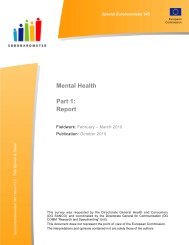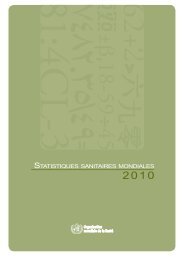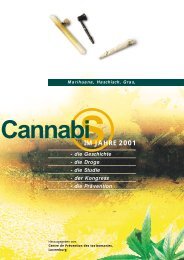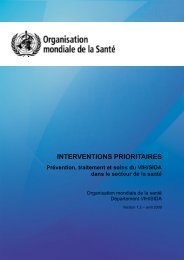Global Tuberculosis Control 2010 - Florida Department of Health
Global Tuberculosis Control 2010 - Florida Department of Health
Global Tuberculosis Control 2010 - Florida Department of Health
You also want an ePaper? Increase the reach of your titles
YUMPU automatically turns print PDFs into web optimized ePapers that Google loves.
A case study from China, which illustrates how strengthening<br />
surveillance can lead to increased notifications<br />
<strong>of</strong> TB cases and an increase in the CDR, is provided in<br />
. Engagement <strong>of</strong> all care providers is discussed<br />
in the next section. Strengthening <strong>of</strong> laboratory capacity<br />
and human resource development are discussed in<br />
and , respectively.<br />
<br />
<br />
In many countries, one <strong>of</strong> the best ways to increase case<br />
detection is for NTPs to establish collaboration with the<br />
full range <strong>of</strong> health-care providers. This is component 4<br />
<strong>of</strong> the Stop TB Strategy (), and its two subcomponents<br />
are:<br />
involvement <strong>of</strong> all public, voluntary, corporate and<br />
private providers through Public-Private Mix (PPM)<br />
approaches; and<br />
promotion <strong>of</strong> the International Standards for <strong>Tuberculosis</strong><br />
Care through PPM initiatives.<br />
Efforts to engage all care providers through PPM initiatives,<br />
beyond those which fall under the direct responsibility<br />
<strong>of</strong> the NTP (termed “non-NTP providers” in this<br />
report), are being introduced and scaled up in many<br />
countries. Unfortunately, demonstrating this progress<br />
is not always possible. First, it requires that systematic<br />
recording and reporting <strong>of</strong> the source <strong>of</strong> referral and<br />
place <strong>of</strong> TB treatment is being done. Second, it requires<br />
that data reported at the local level are aggregated, analysed<br />
and reported at the national level. 1 Often, one or<br />
both conditions are not yet met.<br />
Despite this recording and reporting challenge, substantial<br />
progress in engaging non-NTP care providers<br />
through PPM can be documented for an increasing<br />
number <strong>of</strong> countries. New and compelling data compiled<br />
from 15 countries (including nine HBCs) in <strong>2010</strong>, which<br />
demonstrate the major contribution that PPM can make<br />
to case notifications, are summarized in . In<br />
these 15 countries, the contribution <strong>of</strong> PPM initiatives<br />
typically ranges from between about one fifth to one<br />
third <strong>of</strong> total notifications, in the geographical areas in<br />
which PPM has been implemented. This has been accompanied<br />
by maintenance <strong>of</strong> high rates <strong>of</strong> treatment success<br />
(data not shown).<br />
As also illustrated in , NTPs have used a variety<br />
<strong>of</strong> approaches to engage non-NTP care providers,<br />
according to the local context. These include incentivebased<br />
schemes for individual and institutional providers<br />
in India and Myanmar; a web-based system for mandatory<br />
reporting <strong>of</strong> TB cases by all providers in China<br />
1<br />
WHO recommends that the source <strong>of</strong> referral and the place <strong>of</strong> treatment<br />
should be routinely recorded and reported.

















